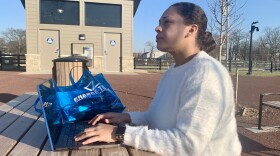New grocery stores are coming to east Louisville, but not to some parts of the city where getting wholesome food is a struggle.
Across town in the Russell neighborhood, options for fresh food and grocery are few, and some residents only have gas stations, food marts and dollar stores to bank on. All of west Louisville, whose residents are mostly Black and low-income, has just three full-service grocery stores.
Mattie Smith, 86, has lived in Russell for 26 years. She said she’s more likely to get fast food and eggs past their expiration date than fresh vegetables and nutritious options.
“Some of these stores have nothing to offer for me. If we had something where we had a variety of food, meat, that’s what we need down here,” she said.
Her neighbor Shalane Turner said the nearest Kroger on Broadway is always busy and runs out of food fast, often turning what should be a trip to one grocery store into a trek.
“Time is precious. A lot of times people want to get back home within the hour and they’re out a couple of hours shopping because it’s further out. We have so much to do already, and we just want to be able to enjoy our time living,” she said.
The store closest to Turner’s house has milk, eggs, snacks, frozen food, cuts of meat and sandwiches that cost $7 apiece.

While Turner has a car that allows her to visit multiple stores, Smith is a senior who relies on her daughter to make grocery trips three times a week. And many residents use the city’s TARC bus system, which is limited in routes and frequency.
West Louisville is one of the city’s food deserts, an area that lacks grocery stores and fresh produce. According to the Greater Louisville Project, a recently closed organization that created data-based reports, one in five city residents lives in a food desert, and more than two-thirds of Louisville’s households without a vehicle live more than a mile from a grocery store.
Smith said she thinks having a full-service grocery store close to home would be a win-win for both the community and the corporation.
“It would make a big difference. They wouldn’t have to worry about making the profit, they would get them,” she said.
But it’s not as straightforward as that.
Phil Lempert, a California-based grocery industry expert who has decades of experience analyzing food trends for media outlets and consulting firms, said the average supermarket has to operate on razor-thin margins of 1.5% net profit a year, and most low-income neighborhoods or food deserts are less likely to take priority due to the uncertainty around profits.
“They closed because they couldn't make money, whether it was the assortment of what they were selling, whether it was crime or just attracting a good labor force,” he said.
But it’s time for the supermarket structure to be reimagined in food-insecure areas, Lempert said, especially after the COVID-19 pandemic.
“The traditional model of a supermarket doesn’t work anymore, it’s a dinosaur. The solution is not a 40,000- to 45,000-square foot supermarket. It’s investing in models that keep different consumers and neighborhood issues in mind,” he said.
One model, he posits, could be Detroit’s Peaches and Greens market which is a produce truck that serves neighborhoods that lack access to fresh food. It also solves the problem of having to travel miles to stores and saves residents time, Lempert said.
It’s similar to the mobile market by Kroger and Dare to Care, a food pantry nonprofit that partnered to launch a single grocery aisle-market in 2019. It makes two to three stops a day around west Louisville and accepts EBT.
Taylor Ryan is the executive director of Change Today, Change Tomorrow, a nonprofit that runs Feed the West, a pantry that serves West End neighborhoods. She said the area is a missed opportunity for grocers.
“Honestly, more people need food. You think you can make money in an area with 20 other stores competing with you, then obviously you’d make money in an area with no grocery stores,” she said.
West Louisville residents Turner and Smith said they were concerned that the high crime rate was a possible reason companies aren’t choosing their area to build grocery stores.
But Ryan said rooting out food insecurity would pave the way for reducing crime.
“When you give people access to fresh food and food that can help them live and sustain, you will alleviate crime,” she said.





